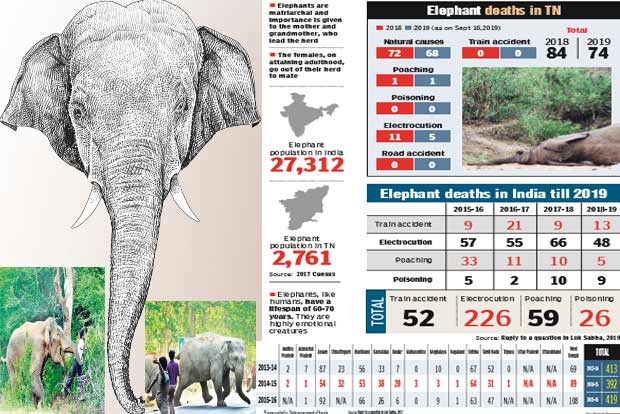Begin typing your search...
Man vs Wild
As human settlements expand and new areas are being found to colonise, elephants are being pushed to the brink, who in turn resort to destruction and damage.

Chennai
Earlier this year, an elephant attacked commuters on a highway cutting through Hosur, repeatedly. Forest officials watched the elephant’s movements for a while before they were able to capture it and transport the pachyderm safely to a dense forest away from human habitation. “We are continuously tracking the movement of this elephant on my mobile, through a remote-digital tracker collar tagged to it,” said Raman Sukumar, professor at the Indian Institute of Science, Bengaluru. He has studied Indian elephants and their behaviour for over 40 years. The highway had cut into elephant territory, probably dividing its habitat on either side of the highway, causing it to retaliate in anger. As poaching, encroachment into forest areas and the urbanisation of peripheral areas destroy elephant habitats, the pachyderms are being forced to seek new habitats within urban clusters, often being destructive in the process.
Human-elephant conflict
As the lifelines of development such as railway lines and highways cut through their traditional migratory corridors, elephants are turning destructive.
“They become crop raiders and move to sugarcane fields for easy fodder as each elephant needs about 100-160 kg of green food every day and water in huge quantities that now is available in the irrigated agricultural fields. With the many large boundary walls of educational institutions and ashrams in the vicinity, the elephants lose their way back to the forest, hence the conflict begins with the local human population, resulting in killing of elephants and human beings,” elaborated Ashutosh Samant Singhar, former Additional Principal Chief Conservator of Forests, Tamil Nadu. “From last year, the National Highways Authority of India (NHAI) has started taking help of forest officials right at the planning and DPR stage,” said Singhar. This is expected to ensure better planning of development initiatives.
The train tracks in the Coimbatore-Walayar (Kerala)-Palghat and Hosur-Dharmapuri area are prone to accidents and the State Forest department is talking to Southern Railway to reduce the speed of trains running in the identified elephant zones and training forest-watchers to warn the Railways if elephants are sighted crossing the tracks. The department is also putting up warning boards along the elephant-crossing zones for the engine drivers to slow down and prohibit the local population from throwing garbage near railway tracks as they attract elephants.
Electric fencing
The State wildlife department is trying to get the Electricity Board to increase the height of the high-transmission electrical wires in the identified zones. In cases where local population is attempting to kill elephants by illegally fencing their crop areas with electric wires, the offenders could be booked under the Wildlife Act and other anti-crime provisions.
This conflict also leads to human casualties. In 2019, around 50 people were killed by elephants in Tamil Nadu. “Elephants, unlike tigers, are not killers, but it is the threat perception by them that makes them attack. When they raid crops, they are chased away by people. But suddenly, a couple of wild elephants in the herd may decide to stop and turn around, with a high probability of men in close proximity being attacked by them. The best advice to people is to avoid any scope of close interaction with the wild elephants,” said Sukumar.
“There is an increase in cases of human beings killed by elephants, especially in the Coimbatore area, with about 5-10 people reported to be losing their lives almost every year.” said Dr C Arivazhagan, managing trustee of the Indo-American Wildlife Society.
Ivory catch
Although official records state that there are no cases of poaching of elephants reported, experts involved in anti-trafficking and anti-wildlife crime, on the condition of confidentiality, said that “poaching continues even today, but the modus operandi has changed. Killing of tuskers for ivory is far more prevalent in Tamil Nadu, Karnataka and Kerala. A majority of tuskers are found in these Southern states, unlike the elephants of the north-eastern states like Assam, where the male makhnas are mostly toothless. While hunting has stopped, the wild tuskers are poisoned with pesticides. They are then shown as natural deaths”.
In a recent case in the Sathyamangalam forests, between 200 and 250 elephants were reported to have died a natural death within a short period of time. Around the same time, there was a large haul of approximately 500 kg of illegal ivory seized in Delhi. Deeper investigation led the authorities to the gangs involved in poaching in the Tamil Nadu-Kerala-Karnataka tri-junction. Wildlife experts say there are many inter-State gangs that are active even now, and they escape from one State to another to hoodwink the State law enforcement agencies.
Poachers sell this ivory cache anywhere in the range of Rs 50,000-1,00,000 in the black market, and they are finally smuggled to countries like China and Japan (there is a huge demand for decorative, medicinal and religious purposes), at a price that could be 10 times higher than domestic prices, through Nepal and Burma. Experts do not rule out the involvement of a few government officials in the black market for ivory, despite the official bans. There are even cases of smuggling of live elephants to China and other South Asian countries, through Nepal, for the purpose of using them on tourist circuits and elephant safaris in those countries.
Forest department officials, however, say they conduct close to 30 or 40 anti-poaching camps every year in each of the 20-odd forest divisions of the State. They believe that over the past 20 years or so, these camps have helped to bring poaching to an end.
“Poaching is not an issue now, following close monitoring and comprehensive anti-poaching camps undertaken regularly for years,” said Sanjay Kumar Srivastava, Chief Wildlife Warden, Tamil Nadu. Anti-trafficking experts say forest guards are not well equipped, lack training and modern equipment and are not paid well enough.
As a result, a few look the other way, when these crimes are committed, in order to make a quick buck.
Little-known facts
As a herd of elephants walks across the flume, the baby in the group decides to stay back in the stream and starts splashing in it. The mother and another sub-adult in the group go back to pull the calf out. The mother taps her admonishingly, but the calf throws a tantrum. At this, the sub-adult, probably an older sibling, kicks her as if to teach her a lesson. The calf, quietly but resentfully, falls in line.
Earlier this year in Tiruchy, a temple elephant killed its mahout of many years. The reason–the mahout and the elephant had for many years had an understanding. The offerings of devotees would be shared; the mahout taking the money and material, the elephant taking the fruits. In the days preceding the incident, the mahout had been denying him the fruits! The elephant attacked the mahout in a fit of anger. Clearly, elephants have a sense of fair play.
Elephants are known to be emotional, like humans. They have a long lifespan, cherish their young and give the older members of their group the last word. They have a lifespan of 60-70 years.
Males, when they are 10-12 years old, are sent out of the herd to avoid inbreeding. They form a bachelors’ group, and roam freely in the forest till they get attached to different herds. When a sub-adult elephant sees a threat from a human being, it sends out a sub-sonic warning signal to the other members. The females, on attaining adulthood, go out of their herd to meet the male elephants who after presenting their best physical credentials to the female elephant, get accepted and go out to mate. When she conceives, she goes back to her mother’s herd for her pregnancy (lasting 18–20 months) and delivery.
“Elephants have poor eyesight, but have a strong sense of smell and hearing and can hear infrasonic sounds. Only when the herd’s head, the eldest female or the grandmother gets angry, the entire herd gets into attack mode. And the only way to escape their attack, is to run for one’s life,” said Arivazhagan.
And elephants, it appears, also enjoy their ‘drink’! Some years ago, when a newly-inducted forest officer went on his tour in a forest near Coimbatore, forest guards discouraged him from visiting an area where a herd of elephants was camping. When the officer persisted, he found a herd of elephants drunk on the locally brewed arrack illicitly manufactured by the local tribesmen. Not a single vat was broken or destroyed; they had emptied them out by sucking out the alcohol!
Like human beings, some elephants are also employed by the government, working for the forest departments, with all the government perks and salary as defined by the State. Some of these include calves abandoned by their herds. Wild elephants abandon a calf if it has been touched by a human. They are generally rescued and put in the custody of a woman, generally the wife of a forest guard or a mahout, who rears these calves like a child.
- News Research Department
Visit news.dtnext.in to explore our interactive epaper!
Download the DT Next app for more exciting features!
Click here for iOS
Click here for Android
Next Story



